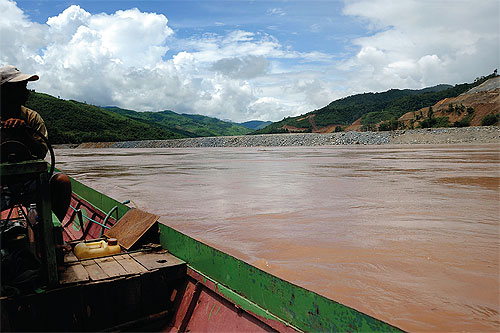Construction forges ahead at Xayaburi Dam project
BOATMEN STRUGGLE TO NAVIGATE MEKONG RIVER AS DYKE HINDERS SAFE PASSAGE
- Published: 22/07/2012 at 02:35 AM
- Newspaper section: News
Construction work is still under way at the
controversial Xayaburi Dam site _ including a dyke straddling the Mekong
River _ despite claims by the Lao government that the work is only
preliminary and promises that the project will proceed only with the
approval of regional neighbours.
 BLOCKAGE: A large gravel based dyke that is being built across a
section of the Mekong River, which locals say is obstructing the passage
of boats.
BLOCKAGE: A large gravel based dyke that is being built across a
section of the Mekong River, which locals say is obstructing the passage
of boats.On Monday and Tuesday the Lao government invited an international group of ambassadors, advocates and donors to attend a meeting and inspect select parts of the Xayaburi site.
- INTERVIEW: Laos denies lying
Ten construction trucks were seen busily working on the dyke when the Post team visited.
On one side of the river bank next to the extensive ''preliminary construction'', a large concrete base is in place and sections of the hillside have been flattened. There are paved roads and buildings in some work camps.
Boatmen said the dyke had made it difficult to navigate the river as the smaller opening had stronger currents.
Ban Houay Souy villagers near the dam have already been relocated and their former homes flattened to make way for trucks and other heavy machinery.
''Our folk still pass through the channel back and forth to transport teak planks, pillars, and such, from the houses demolished as a result of the relocation from Ban Houy Souy,'' one boatman said.
''But a small longtail boat cannot pass as the current around the channel is strong''.
Security at the dam site has also been stepped up, with a checkpoint on the road leading to the camps, which bars outsiders and relocated villagers.
Ban Talan village, next to the inner camp, has not yet been relocated. The villagers said they had been told they would be relocated but were not given a date.
Ch Karnchang, the Thai developer of the $US3.8 billion (120 billion baht) project, last week shrugged off the Lao government's announcement that it had postponed the project, with company chairman Aswin Kongsiri saying they were waiting for the official word.
He said they had scheduled time for possible delays and expected to finish on target in 2020. Mr Aswin also said Ch Karnchang had not begun construction of the dam but rather has only built an access road to the site, adding the roadwork would continue.
Ninety-five percent of the electricity generated by the dam is to be sold to the Electricity Generating Authority of Thailand at a price of about two baht per kilowatt per hour.
The Mekong River Commission _ comprising Thailand, Laos, Cambodia and Vietnam _ has not yet given unanimous approval for the project, although there have been many media and NGO reports that the work has been progressing.
Critics say it will damage the Mekong ecosystem and the livelihoods of downriver communities.
In late 2010, the Lao government submitted the project to the Mekong River Commission in a bid to make it transparent and accountable, kicking off the six-month consultation period with other Mekong countries under the 1995 Mekong agreement.
But it was later revealed that preliminary construction work was under way despite other MRC members not giving their approval.
At a meeting in April last year at the end of the consultation process, the member countries could not reach a consensus. They deferred the issue to a ministerial-level meeting late last year, which agreed to a study on sustainable management and development of the Mekong River including the impact of hydropower projects.
Laos' Deputy Minister of Energy and Mines Ministry Viraphonh Viravong said in an interview with the Bangkok Post Sunday that the consultation process for the Xayaburi Dam was completed in April last year, and Laos fully complied with the Mekong agreement.
He said there was a misrepresentation in the media that Laos had proceeded with the project and then made a U-turn by announcing it was halted.
Mr Viraphonh said Laos had not started any permanent construction and had not given permission for the developers to do so.
He said work at the site, including in the river and on its banks, was only preparatory.
He said it was part of ''the survey work, or a sub-surface geological investigation, which needs to be carried out to facilitate the flushing structure [of the dam] which would be built many metres in the ground''.
When Mr Viraphonh was asked what constituted ''preparatory work'', he said any structure not of a permanent nature intended to support the project development.
''Considering the Mekong agreement, Laos has the right to construct the project,'' he said.
From - Bangkok post










0 comments:
Post a Comment